Analyzing Conflict: Concepts, Resolution, and Organizational Impact
VerifiedAdded on 2020/03/16
|6
|1469
|65
Report
AI Summary
This report examines the multifaceted concept of conflict within organizational settings. It defines conflict as arising from perceived threats or contrasting values, and explores its evolution from a traditionally avoided issue to a recognized, and sometimes necessary, element for growth. The report differentiates between functional and dysfunctional conflict, and addresses conflict at micro and macro levels, including interpersonal and intraindividual conflicts. It emphasizes the importance of conflict resolution through compromise, accommodation, competition, collaboration, and avoidance. The report includes three responses discussing dividend yield, team efficacy, and team building, and concludes with a comprehensive list of references.
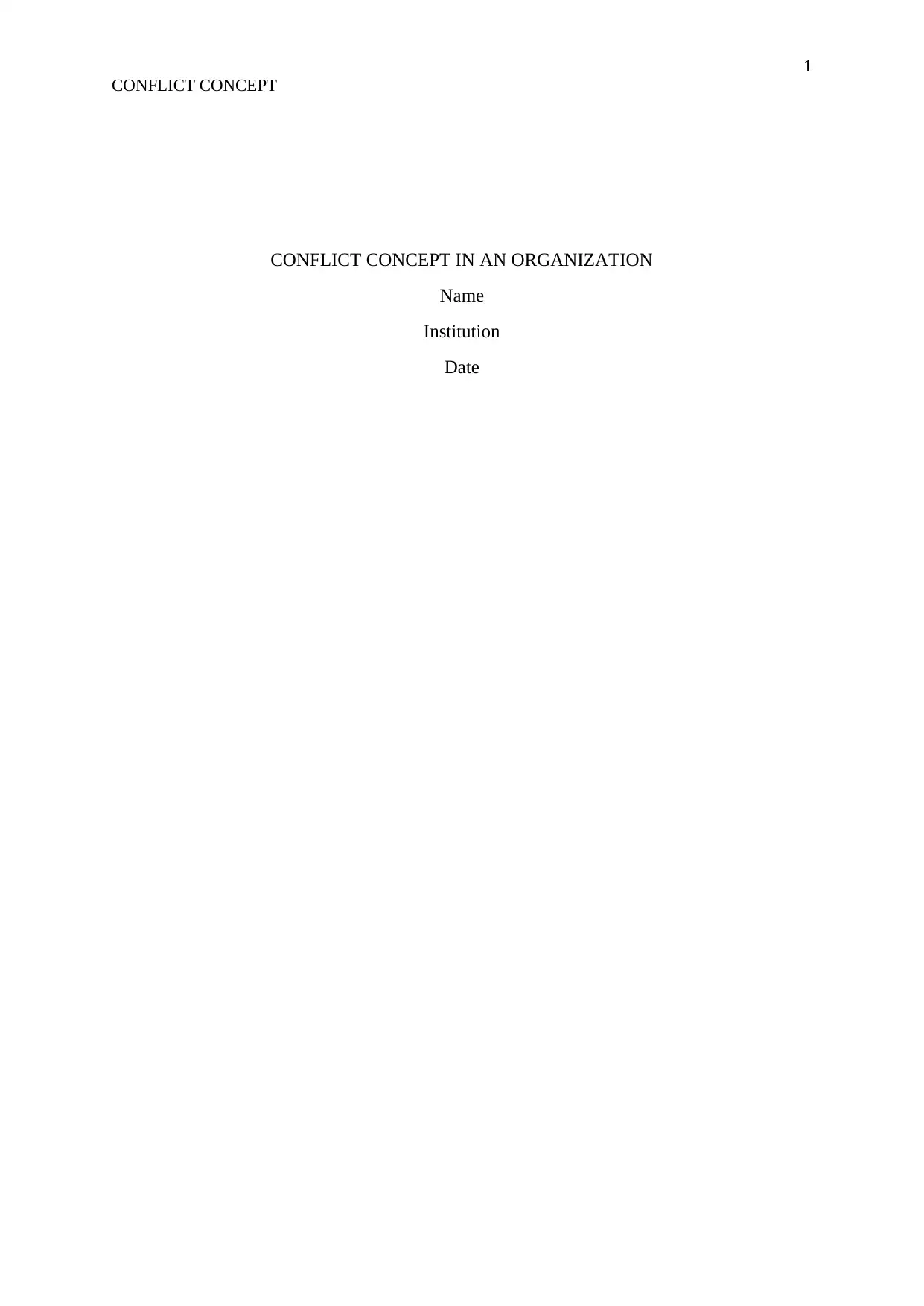
1
CONFLICT CONCEPT
CONFLICT CONCEPT IN AN ORGANIZATION
Name
Institution
Date
CONFLICT CONCEPT
CONFLICT CONCEPT IN AN ORGANIZATION
Name
Institution
Date
Paraphrase This Document
Need a fresh take? Get an instant paraphrase of this document with our AI Paraphraser
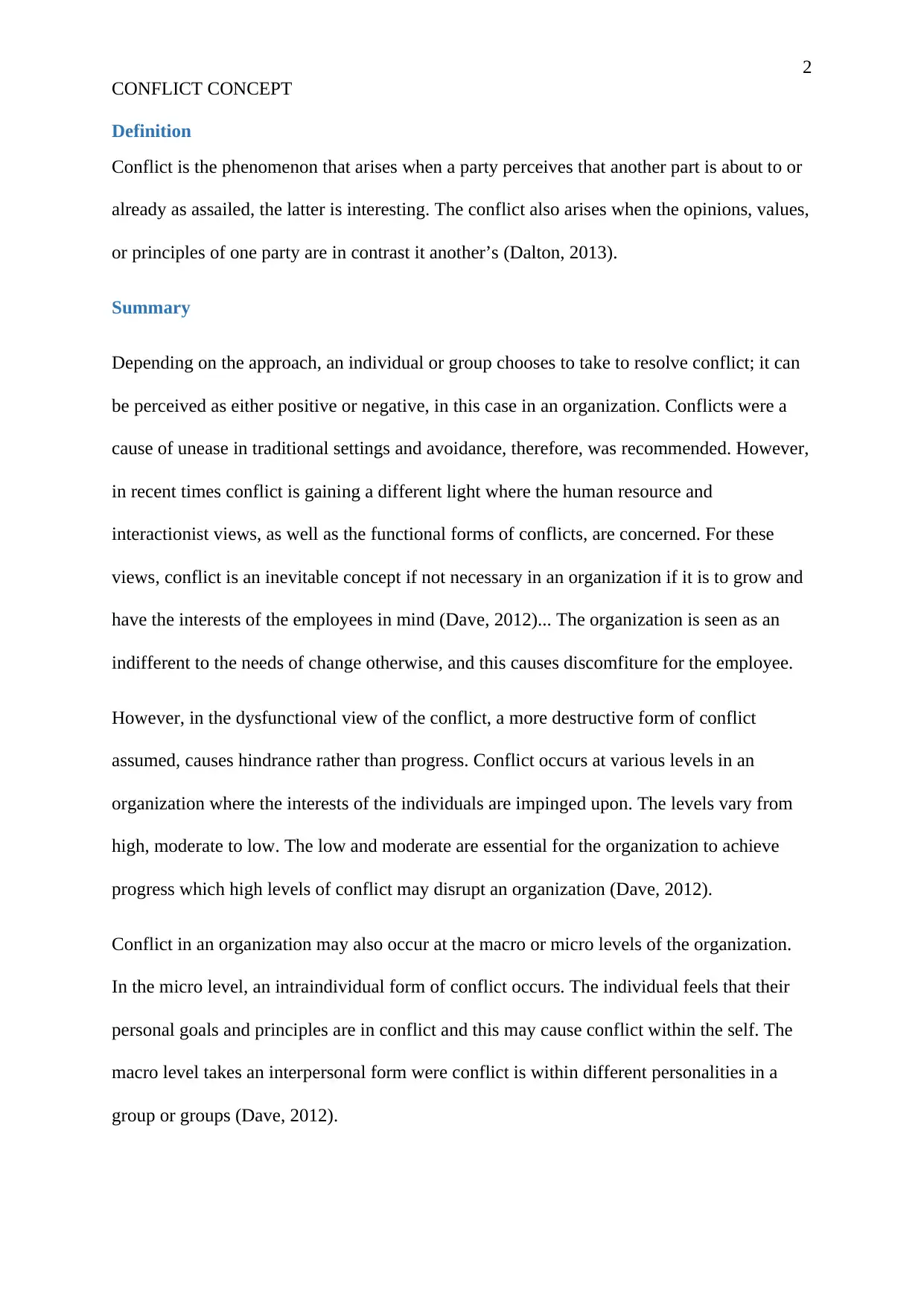
2
CONFLICT CONCEPT
Definition
Conflict is the phenomenon that arises when a party perceives that another part is about to or
already as assailed, the latter is interesting. The conflict also arises when the opinions, values,
or principles of one party are in contrast it another’s (Dalton, 2013).
Summary
Depending on the approach, an individual or group chooses to take to resolve conflict; it can
be perceived as either positive or negative, in this case in an organization. Conflicts were a
cause of unease in traditional settings and avoidance, therefore, was recommended. However,
in recent times conflict is gaining a different light where the human resource and
interactionist views, as well as the functional forms of conflicts, are concerned. For these
views, conflict is an inevitable concept if not necessary in an organization if it is to grow and
have the interests of the employees in mind (Dave, 2012)... The organization is seen as an
indifferent to the needs of change otherwise, and this causes discomfiture for the employee.
However, in the dysfunctional view of the conflict, a more destructive form of conflict
assumed, causes hindrance rather than progress. Conflict occurs at various levels in an
organization where the interests of the individuals are impinged upon. The levels vary from
high, moderate to low. The low and moderate are essential for the organization to achieve
progress which high levels of conflict may disrupt an organization (Dave, 2012).
Conflict in an organization may also occur at the macro or micro levels of the organization.
In the micro level, an intraindividual form of conflict occurs. The individual feels that their
personal goals and principles are in conflict and this may cause conflict within the self. The
macro level takes an interpersonal form were conflict is within different personalities in a
group or groups (Dave, 2012).
CONFLICT CONCEPT
Definition
Conflict is the phenomenon that arises when a party perceives that another part is about to or
already as assailed, the latter is interesting. The conflict also arises when the opinions, values,
or principles of one party are in contrast it another’s (Dalton, 2013).
Summary
Depending on the approach, an individual or group chooses to take to resolve conflict; it can
be perceived as either positive or negative, in this case in an organization. Conflicts were a
cause of unease in traditional settings and avoidance, therefore, was recommended. However,
in recent times conflict is gaining a different light where the human resource and
interactionist views, as well as the functional forms of conflicts, are concerned. For these
views, conflict is an inevitable concept if not necessary in an organization if it is to grow and
have the interests of the employees in mind (Dave, 2012)... The organization is seen as an
indifferent to the needs of change otherwise, and this causes discomfiture for the employee.
However, in the dysfunctional view of the conflict, a more destructive form of conflict
assumed, causes hindrance rather than progress. Conflict occurs at various levels in an
organization where the interests of the individuals are impinged upon. The levels vary from
high, moderate to low. The low and moderate are essential for the organization to achieve
progress which high levels of conflict may disrupt an organization (Dave, 2012).
Conflict in an organization may also occur at the macro or micro levels of the organization.
In the micro level, an intraindividual form of conflict occurs. The individual feels that their
personal goals and principles are in conflict and this may cause conflict within the self. The
macro level takes an interpersonal form were conflict is within different personalities in a
group or groups (Dave, 2012).
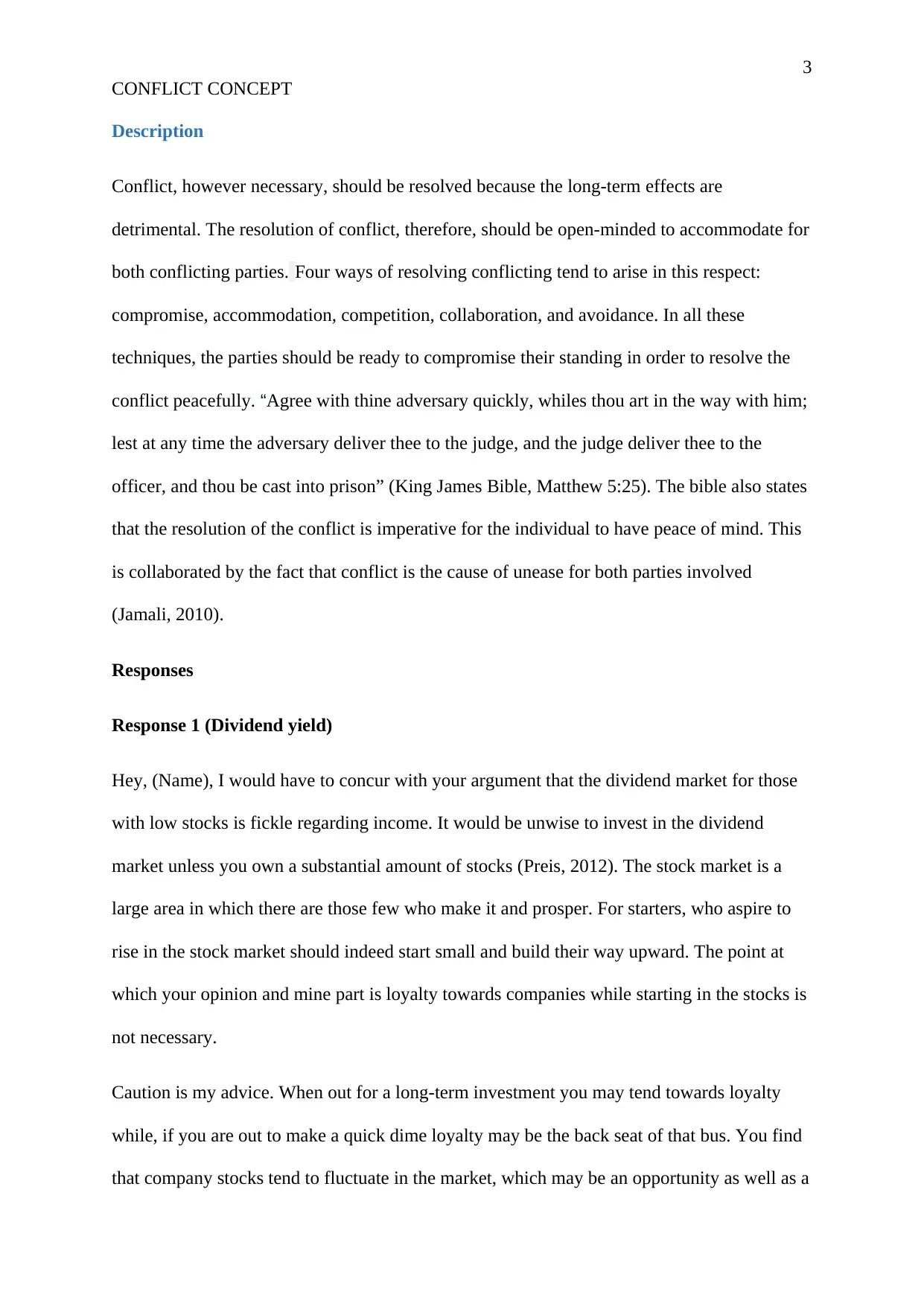
3
CONFLICT CONCEPT
Description
Conflict, however necessary, should be resolved because the long-term effects are
detrimental. The resolution of conflict, therefore, should be open-minded to accommodate for
both conflicting parties. Four ways of resolving conflicting tend to arise in this respect:
compromise, accommodation, competition, collaboration, and avoidance. In all these
techniques, the parties should be ready to compromise their standing in order to resolve the
conflict peacefully. “Agree with thine adversary quickly, whiles thou art in the way with him;
lest at any time the adversary deliver thee to the judge, and the judge deliver thee to the
officer, and thou be cast into prison” (King James Bible, Matthew 5:25). The bible also states
that the resolution of the conflict is imperative for the individual to have peace of mind. This
is collaborated by the fact that conflict is the cause of unease for both parties involved
(Jamali, 2010).
Responses
Response 1 (Dividend yield)
Hey, (Name), I would have to concur with your argument that the dividend market for those
with low stocks is fickle regarding income. It would be unwise to invest in the dividend
market unless you own a substantial amount of stocks (Preis, 2012). The stock market is a
large area in which there are those few who make it and prosper. For starters, who aspire to
rise in the stock market should indeed start small and build their way upward. The point at
which your opinion and mine part is loyalty towards companies while starting in the stocks is
not necessary.
Caution is my advice. When out for a long-term investment you may tend towards loyalty
while, if you are out to make a quick dime loyalty may be the back seat of that bus. You find
that company stocks tend to fluctuate in the market, which may be an opportunity as well as a
CONFLICT CONCEPT
Description
Conflict, however necessary, should be resolved because the long-term effects are
detrimental. The resolution of conflict, therefore, should be open-minded to accommodate for
both conflicting parties. Four ways of resolving conflicting tend to arise in this respect:
compromise, accommodation, competition, collaboration, and avoidance. In all these
techniques, the parties should be ready to compromise their standing in order to resolve the
conflict peacefully. “Agree with thine adversary quickly, whiles thou art in the way with him;
lest at any time the adversary deliver thee to the judge, and the judge deliver thee to the
officer, and thou be cast into prison” (King James Bible, Matthew 5:25). The bible also states
that the resolution of the conflict is imperative for the individual to have peace of mind. This
is collaborated by the fact that conflict is the cause of unease for both parties involved
(Jamali, 2010).
Responses
Response 1 (Dividend yield)
Hey, (Name), I would have to concur with your argument that the dividend market for those
with low stocks is fickle regarding income. It would be unwise to invest in the dividend
market unless you own a substantial amount of stocks (Preis, 2012). The stock market is a
large area in which there are those few who make it and prosper. For starters, who aspire to
rise in the stock market should indeed start small and build their way upward. The point at
which your opinion and mine part is loyalty towards companies while starting in the stocks is
not necessary.
Caution is my advice. When out for a long-term investment you may tend towards loyalty
while, if you are out to make a quick dime loyalty may be the back seat of that bus. You find
that company stocks tend to fluctuate in the market, which may be an opportunity as well as a
⊘ This is a preview!⊘
Do you want full access?
Subscribe today to unlock all pages.

Trusted by 1+ million students worldwide
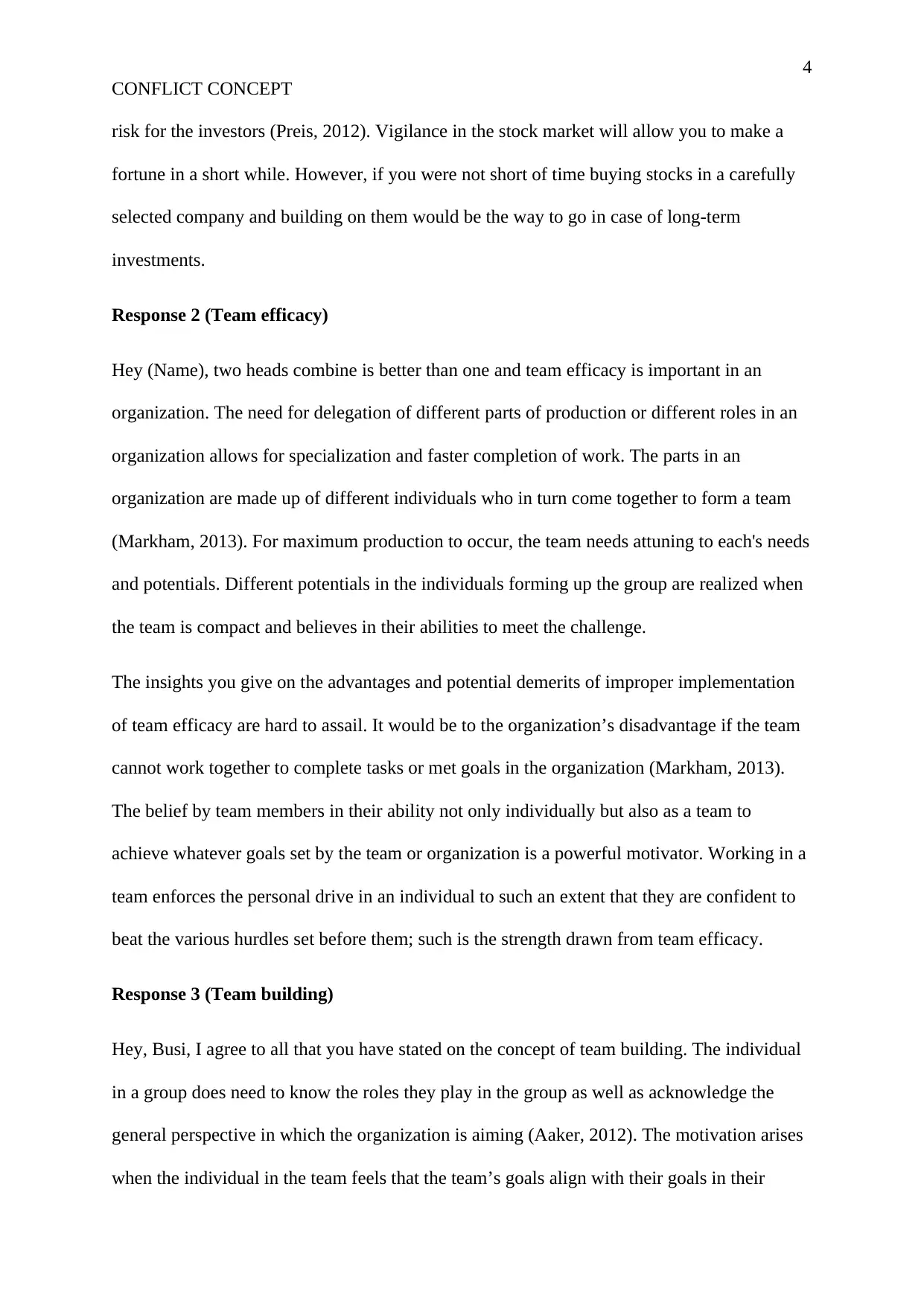
4
CONFLICT CONCEPT
risk for the investors (Preis, 2012). Vigilance in the stock market will allow you to make a
fortune in a short while. However, if you were not short of time buying stocks in a carefully
selected company and building on them would be the way to go in case of long-term
investments.
Response 2 (Team efficacy)
Hey (Name), two heads combine is better than one and team efficacy is important in an
organization. The need for delegation of different parts of production or different roles in an
organization allows for specialization and faster completion of work. The parts in an
organization are made up of different individuals who in turn come together to form a team
(Markham, 2013). For maximum production to occur, the team needs attuning to each's needs
and potentials. Different potentials in the individuals forming up the group are realized when
the team is compact and believes in their abilities to meet the challenge.
The insights you give on the advantages and potential demerits of improper implementation
of team efficacy are hard to assail. It would be to the organization’s disadvantage if the team
cannot work together to complete tasks or met goals in the organization (Markham, 2013).
The belief by team members in their ability not only individually but also as a team to
achieve whatever goals set by the team or organization is a powerful motivator. Working in a
team enforces the personal drive in an individual to such an extent that they are confident to
beat the various hurdles set before them; such is the strength drawn from team efficacy.
Response 3 (Team building)
Hey, Busi, I agree to all that you have stated on the concept of team building. The individual
in a group does need to know the roles they play in the group as well as acknowledge the
general perspective in which the organization is aiming (Aaker, 2012). The motivation arises
when the individual in the team feels that the team’s goals align with their goals in their
CONFLICT CONCEPT
risk for the investors (Preis, 2012). Vigilance in the stock market will allow you to make a
fortune in a short while. However, if you were not short of time buying stocks in a carefully
selected company and building on them would be the way to go in case of long-term
investments.
Response 2 (Team efficacy)
Hey (Name), two heads combine is better than one and team efficacy is important in an
organization. The need for delegation of different parts of production or different roles in an
organization allows for specialization and faster completion of work. The parts in an
organization are made up of different individuals who in turn come together to form a team
(Markham, 2013). For maximum production to occur, the team needs attuning to each's needs
and potentials. Different potentials in the individuals forming up the group are realized when
the team is compact and believes in their abilities to meet the challenge.
The insights you give on the advantages and potential demerits of improper implementation
of team efficacy are hard to assail. It would be to the organization’s disadvantage if the team
cannot work together to complete tasks or met goals in the organization (Markham, 2013).
The belief by team members in their ability not only individually but also as a team to
achieve whatever goals set by the team or organization is a powerful motivator. Working in a
team enforces the personal drive in an individual to such an extent that they are confident to
beat the various hurdles set before them; such is the strength drawn from team efficacy.
Response 3 (Team building)
Hey, Busi, I agree to all that you have stated on the concept of team building. The individual
in a group does need to know the roles they play in the group as well as acknowledge the
general perspective in which the organization is aiming (Aaker, 2012). The motivation arises
when the individual in the team feels that the team’s goals align with their goals in their
Paraphrase This Document
Need a fresh take? Get an instant paraphrase of this document with our AI Paraphraser
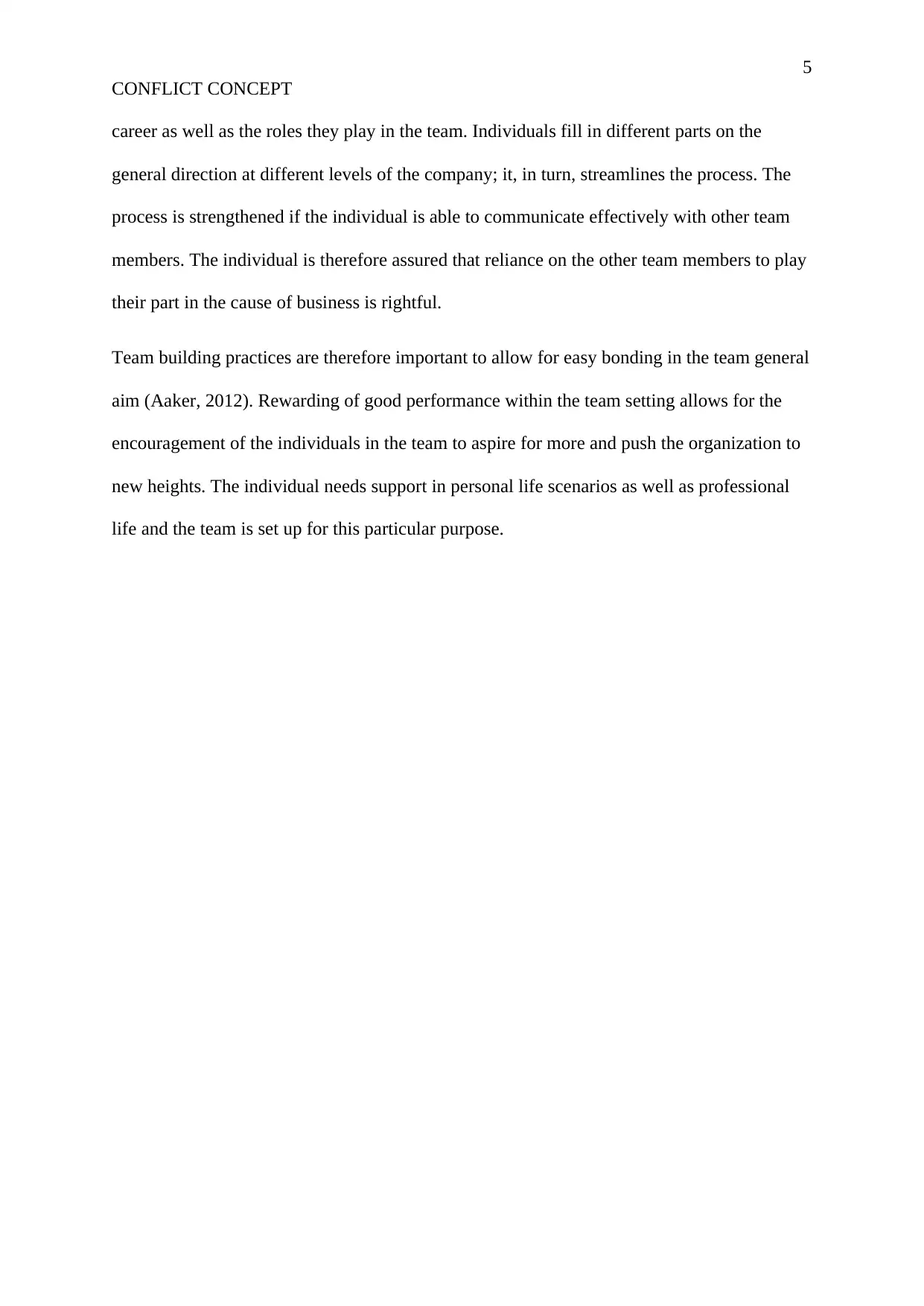
5
CONFLICT CONCEPT
career as well as the roles they play in the team. Individuals fill in different parts on the
general direction at different levels of the company; it, in turn, streamlines the process. The
process is strengthened if the individual is able to communicate effectively with other team
members. The individual is therefore assured that reliance on the other team members to play
their part in the cause of business is rightful.
Team building practices are therefore important to allow for easy bonding in the team general
aim (Aaker, 2012). Rewarding of good performance within the team setting allows for the
encouragement of the individuals in the team to aspire for more and push the organization to
new heights. The individual needs support in personal life scenarios as well as professional
life and the team is set up for this particular purpose.
CONFLICT CONCEPT
career as well as the roles they play in the team. Individuals fill in different parts on the
general direction at different levels of the company; it, in turn, streamlines the process. The
process is strengthened if the individual is able to communicate effectively with other team
members. The individual is therefore assured that reliance on the other team members to play
their part in the cause of business is rightful.
Team building practices are therefore important to allow for easy bonding in the team general
aim (Aaker, 2012). Rewarding of good performance within the team setting allows for the
encouragement of the individuals in the team to aspire for more and push the organization to
new heights. The individual needs support in personal life scenarios as well as professional
life and the team is set up for this particular purpose.
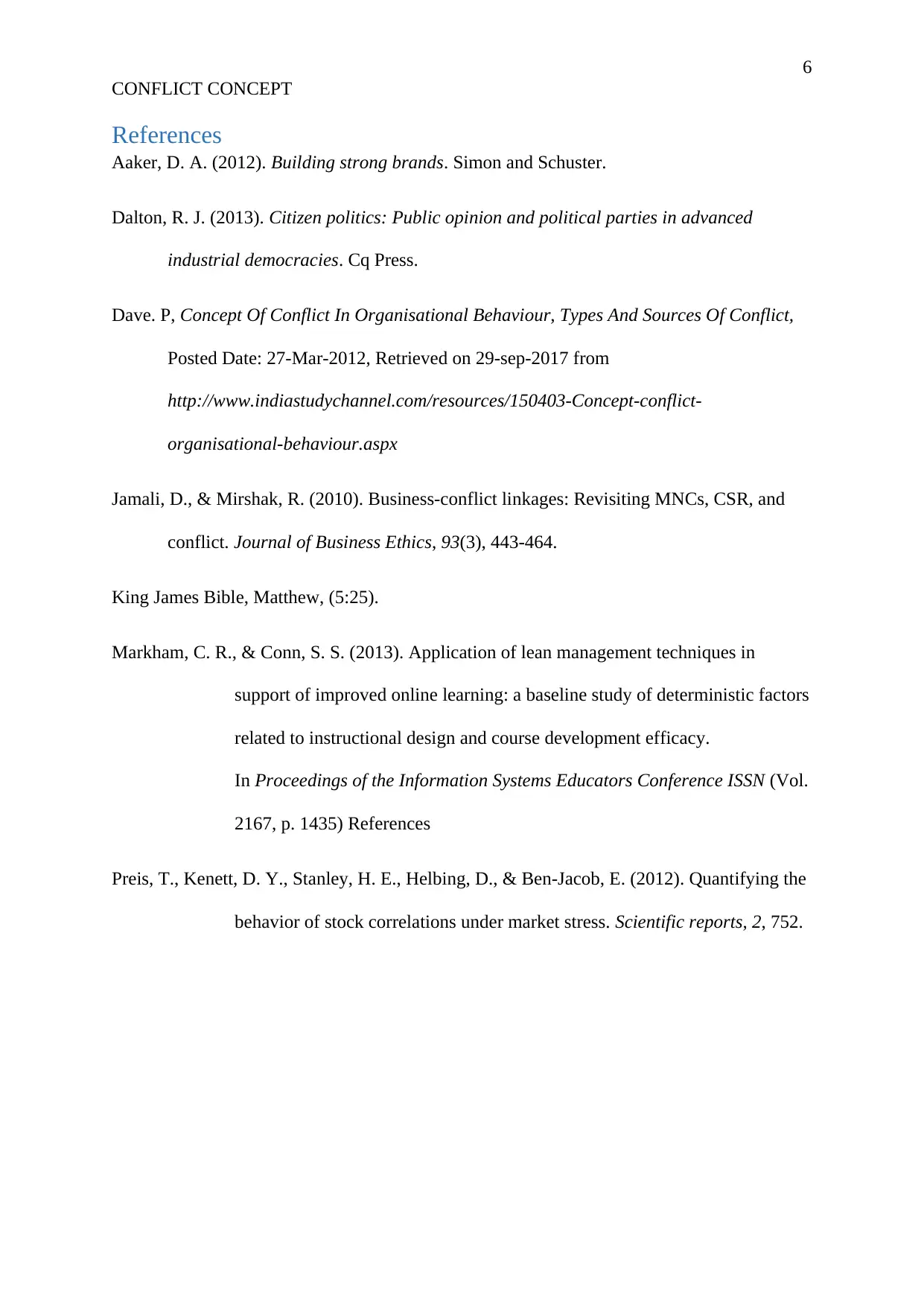
6
CONFLICT CONCEPT
References
Aaker, D. A. (2012). Building strong brands. Simon and Schuster.
Dalton, R. J. (2013). Citizen politics: Public opinion and political parties in advanced
industrial democracies. Cq Press.
Dave. P, Concept Of Conflict In Organisational Behaviour, Types And Sources Of Conflict,
Posted Date: 27-Mar-2012, Retrieved on 29-sep-2017 from
http://www.indiastudychannel.com/resources/150403-Concept-conflict-
organisational-behaviour.aspx
Jamali, D., & Mirshak, R. (2010). Business-conflict linkages: Revisiting MNCs, CSR, and
conflict. Journal of Business Ethics, 93(3), 443-464.
King James Bible, Matthew, (5:25).
Markham, C. R., & Conn, S. S. (2013). Application of lean management techniques in
support of improved online learning: a baseline study of deterministic factors
related to instructional design and course development efficacy.
In Proceedings of the Information Systems Educators Conference ISSN (Vol.
2167, p. 1435) References
Preis, T., Kenett, D. Y., Stanley, H. E., Helbing, D., & Ben-Jacob, E. (2012). Quantifying the
behavior of stock correlations under market stress. Scientific reports, 2, 752.
CONFLICT CONCEPT
References
Aaker, D. A. (2012). Building strong brands. Simon and Schuster.
Dalton, R. J. (2013). Citizen politics: Public opinion and political parties in advanced
industrial democracies. Cq Press.
Dave. P, Concept Of Conflict In Organisational Behaviour, Types And Sources Of Conflict,
Posted Date: 27-Mar-2012, Retrieved on 29-sep-2017 from
http://www.indiastudychannel.com/resources/150403-Concept-conflict-
organisational-behaviour.aspx
Jamali, D., & Mirshak, R. (2010). Business-conflict linkages: Revisiting MNCs, CSR, and
conflict. Journal of Business Ethics, 93(3), 443-464.
King James Bible, Matthew, (5:25).
Markham, C. R., & Conn, S. S. (2013). Application of lean management techniques in
support of improved online learning: a baseline study of deterministic factors
related to instructional design and course development efficacy.
In Proceedings of the Information Systems Educators Conference ISSN (Vol.
2167, p. 1435) References
Preis, T., Kenett, D. Y., Stanley, H. E., Helbing, D., & Ben-Jacob, E. (2012). Quantifying the
behavior of stock correlations under market stress. Scientific reports, 2, 752.
⊘ This is a preview!⊘
Do you want full access?
Subscribe today to unlock all pages.

Trusted by 1+ million students worldwide
1 out of 6
Your All-in-One AI-Powered Toolkit for Academic Success.
+13062052269
info@desklib.com
Available 24*7 on WhatsApp / Email
![[object Object]](/_next/static/media/star-bottom.7253800d.svg)
Unlock your academic potential
Copyright © 2020–2025 A2Z Services. All Rights Reserved. Developed and managed by ZUCOL.